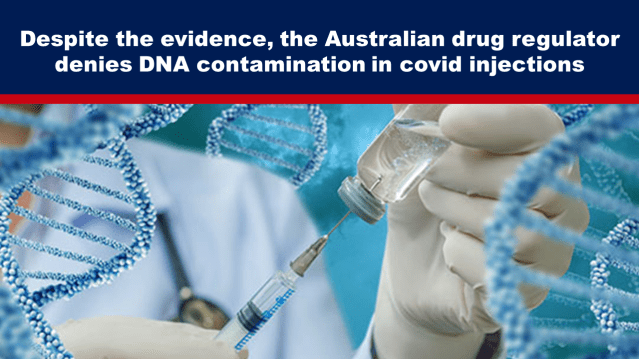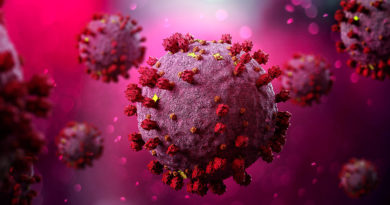Despite the evidence, the Australian drug regulator denies DNA contamination in covid injections
After years of researching mRNA injections and documenting adverse events, we are just beginning to scratch the surface of the depth of corruption in the marketing, manufacturing and militarisation of the covid injections.
Scientists and doctors, journalists and elected officials, parents and students – people from all walks of life, of all ages and with all differing levels of education are joining in on the fight to find out what was pushed on the public, who was behind it and its impact on public health – both now and into the future.
Two years ago, Australian journalist Rebekah Barnett is one of those who joined in the fight. For a year she has been communicating with the Therapeutic Goods Administration on the DNA contamination found in covid injections. But until now, they had neither confirmed nor denied the presence of high levels of DNA contamination.
Yesterday, journalist Rebekah Barnett joined immunologist Dr. Jessica Rose on CHD TV to discuss the DNA contamination of the covid injections.
“I’m not inclined to drop this topic,” Barnett said, “because this is the 100-day vaccine platform now. Everything going forward, obviously there’s going to be exceptions to that, but really the future is mRNA vaccines.”
“I’m concerned with: well, if you’re not admitting the problems with 1.0, then what happens once you make everything mRNA,” she added.
The 100-day vaccine mission aims to develop safe and effective vaccines against emerging infectious diseases within 100 days of identification. This ambitious goal was first proposed by the Coalition for Epidemic Preparedness Innovations (“CEPI”) and has been endorsed by governments worldwide, including the UK government, which designated it as the “100 Days Mission”.
At the time of writing, Dr. Rose and Barnett’s discussion, which was being aired live, had not yet concluded so instead of writing about it, we have republished an article Barnett published yesterday, shortly before she joined Dr. Rose. You can watch the discussion between the two ladies below.
If you are unable to watch the video above on Rumble, you can watch it on the CHD TV website HERE.
Let’s not lose touch…Your Government and Big Tech are actively trying to censor the information reported by The Exposé to serve their own needs. Subscribe now to make sure you receive the latest uncensored news in your inbox…
By Rebekah Barnett, 24 July 2024
The Therapeutic Goods Administration (“TGA”) denies that the Pfizer mRNA covid vaccine is contaminated, as at least four independent labs around the world claim to have detected plasmid DNA contamination in vials of the mRNA Pfizer and Moderna injections, most well over regulatory limits.
I have been communicating with the TGA about the contamination findings since last year, when I first wrote about ‘Covid vaccines and your DNA – what the science tells us (and what it doesn’t)’, for Umbrella News.
Until now, the TGA had neither confirmed nor denied the presence of high levels of DNA contamination. But in a recent email communication to me, a spokesperson for Australia’s drug regulator finally stated unequivocally: “The Pfizer covid vaccine is not contaminated.”
The denial comes as several new studies of DNA contamination in the mRNA injections are due to be released within the month.
Dr. Jessica Rose, a Canadian researcher who worked with molecular virologist Dr. David Speicher (Courageous Truth) on a study of 27 mRNA Covid vaccine vials from 12 lots of Moderna and Pfizer vaccines said that there’s no question the mRNA covid vaccines are contaminated.
She told me, “Of the 54 vials tested in Germany, the US and Canada, all were found to contain DNA in levels that exceed the commercial acceptance criterion level of <330 ng DNA/mg RNA.”
That Canadian study detected “billions to hundreds of billions of DNA molecules per dose,” from primary series and booster lots, as well as lots for children.
Genomics scientist Kevin McKernan (Anandamide), who made the initial discovery of DNA contamination in the mRNA injections and a gene therapy sequence called the SV40 enhancer/promoter in the Pfizer vaccine back in April 2023, found contamination at qPCR cycles much lower than what is used to detect the SARS-CoV-2 virus.
It’s “a million times more than what you might call someone for having a virus in their nose,” said McKernan, who is the founder and Chief Scientific Officer of Medicinal Genomics, and previously managed research and development for the Human Genome Project at Whitehead Institute/MIT. “They’re injecting a million times more contaminant in every shot,” he said. “So, it’s not a small amount.”
Dr. Speicher suggested that it’s also a matter of wording. One could say “the vaccine is not contaminated” because the “residual plasmid DNA” is a process-related impurity, he said. Either way, Dr. Speicher’s research turned up much higher levels of residual DNA in the mRNA shots than is supposed to be there.
Another Study Finds High Levels of Residual DNA in Pfizer Injections
The TGA’s email response to me was in relation to a peer-reviewed study by German scientists Brigitte König and Jürgen Kirchner in May of this year which claimed to show very high amounts of DNA contamination in the Pfizer mRNA vaccine, “ranging from 360 to 534 times the permissible DNA limit.”
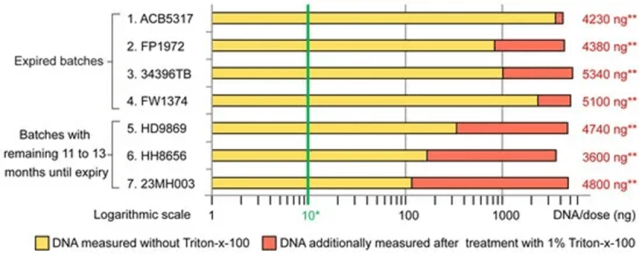
König and Kirchner used a method called fluorescence spectrometry (also called fluorometry) to measure levels of residual DNA in the Pfizer vaccine, which is allowed by regulators in amounts of up to 10 nanograms (ng) per dose at sizes of up to 200 base pairs (bp) in length, based on a maximum dose of 30 micrograms (μg) of RNA.
The DNA is a remnant of the mRNA vaccine production method, which involves using E. coli bacteria to make copies of DNA plasmids, from which the vaccine mRNA is then produced. Any residual DNA is then supposed to be purified out of the mRNA end product.
König and Kirchner criticised regulators’ “methodologically inadequate” protocols for testing DNA levels in the covid vaccines, which would result in a “massive under-detection of DNA impurities.”
While regulators allow manufacturers to use fluorometry to measure levels of mRNA in covid vaccines, a different technique, qPCR, is used to measure DNA levels. But the qPCR method, the authors explain, checks less than 1% of the original template, with the other 99% being extrapolated mathematically.
König and Kirchner were also concerned that the qPCR method does not pick up very small DNA fragments and that DNA at the particular region of the plasmid that Pfizer measures is susceptible to being “masked,” by the enzyme used in the qPCR measurement process, making it less detectable.
Therefore, König and Kirchner set out to measure all of the residual DNA in the Pfizer covid vaccine. First, they used a detergent to disintegrate the LNPs to release the mRNA and any DNA encased within them. They then measured DNA levels through fluorometry, which resulted in the detection of such high levels of contamination.
McKernan discussed the limitations of König and Kirchner’s study on Substack, writing that their estimate is likely to be a 10-fold overestimation. But, “even if you discount this inflation, their lots will still be over the limit.”
“We are no longer debating whether the shots are contaminated,” McKernan said in a recent interview. “We’re just debating whether they are 10-fold or 100-fold over the limit and how much they vary from lot to lot.”
Scientists Question Regulator Protocols for Measuring DNA Levels
The TGA said that König and Kirchner’s findings are invalid because:
“The experimental technique applied in the paper referenced is not the approved method.
“Routine fluorescence measurement of residual DNA is not a feasible approach, as residual DNA is present in very low levels against a background of high levels of RNA.
“Current fluorescence detection systems do not offer sufficient specificity to permit detection of DNA without interference from RNA. This crosstalk in the fluorescent dye will return an overestimation of DNA. rDNA levels are monitored by manufacturers and regulators using more sensitive and specific PCR techniques.”
McKernan agrees that König and Kirchner’s methods produced an overestimate of the DNA levels present in the vials, which he suggested could be addressed by using an enzyme called RNase A to erase the RNA – this would eliminate interference from RNA when measuring the DNA, giving a more accurate reading. Dr Speicher confirmed that he uses RNase A as a control in his tests with fluorometry.
However, McKernan said that König and Kirchner, “correctly point out that the RNA and DNA should both be measured at the same endpoint in manufacturing using the SAME tool.”
“What König et al. highlighted is that the RNA quantity is using fluorometry as an end measurement and they are using qPCR to measure DNA at an earlier step,” he explained further in an email.
“Either use fluorometry for both measurements or qPCR for both measurements. The fact that you allow them to cherry-pick methods to meet the guidelines demonstrates the guidelines are rigged and not sound methodology.”
Dr. Speicher and Dr. Rose agree that the approved qPCR method for measuring residual DNA will underestimate the true amount and that the same method should be used for measuring both mRNA and DNA.
Nevertheless, both McKernan and Dr. Buckhaults found amounts of residual DNA in the mRNA vaccines above regulatory limits using qPCR.1
In Dr. Speicher’s study of 27 vials, all vaccines exceeded regulatory guidelines for residual DNA when measured with fluorometry (using the RNase A control), but were below guideline limits when measured using qPCR, emphasising “the importance of methodological clarity and consistency when interpreting quantitative guidelines.”
Use of Traditional Vaccine DNA Limits a ‘Serious Regulatory Oversight’
Scientists are not just disputing whether the mRNA vaccines are compliant with regulatory limits on residual DNA levels. They also say that the current limits should not apply to new modified RNA vaccine products.
This is because the risk of naked residual DNA, which has a short half-life in the body, is not the same as the risk of DNA encapsulated in lipid nanoparticles (“LNPs”), which ferry their contents to all major organs in the body, where they transfect and dump their contents into cells.
Cancer genomics scientist, Dr. Phillip Buckaults of the University of South Carolina, called the application of standard DNA limits to the mRNA products a “serious regulatory oversight” during his testimony to a state Senate hearing in September last year.
“They inappropriately applied that [traditional] regulatory limit to this new kind of vaccine where everything is encapsulated in this lipid nanoparticle,” he told Senators, warning that “there is a very real hazard” of DNA fragments integrating with a person’s genome and causing rare but serious side effects.
Professor Wafik El-Deiry, Director of the Cancer Centre at Brown University, echoed Dr. Buckhaults’ concerns, stating on X that if the LNPs carrying contaminant DNA get into cells, “they can integrate into the genome which is permanent, heritable and has a theoretical risk of causing cancer depending on where in the genome they integrate.”
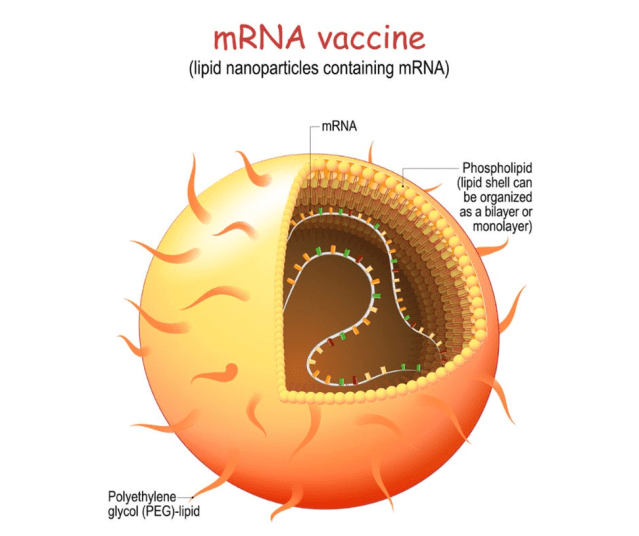
But a TGA spokesperson rejected these concerns, stating: “There is no significance to minute amounts of residual DNA being encapsulated in the LNPs.”
And: “There is no accepted science that shows any alteration of the human genome.“
The TGA also highlighted that the technology used to produce the mRNA from DNA plasmids is not new stating:
“The use of plasmids in cells such as E. coli (and others) is a technology that has been around for many decades. The first pharmaceuticals manufactured using these techniques were approved back in the 1980s. Experts, manufacturers and regulators have been discussing residual DNA safety since then and the guidelines on testing and limits are a result of accepted scientific consensus.”
It is true that biologics made with DNA plasmids are not new. But the LNP casing of these elements rolled out in vaccines en masse is new, and the science around the potential concerns related to this is emerging.
The LNPs have been praised as the technology that allowed the mRNA vaccines to work because they protect the mRNA from degrading as soon as it’s injected into the body.
But, “these LNPs protect the DNA just as much as they protect the RNA,” said McKernan, thereby changing the risk profile of any residual DNA compared to that found in traditional vaccines.
Producing mRNA drugs with DNA plasmids at a mass scale is also new, posing new challenges for the DNA purification process, said König and Kirchner in their paper. Ordinarily, DNA purification is “rarely a problem,” because genetically engineered drugs are predominantly proteins, and these are fairly easily separated out from residual DNA due to their chemical differences.
However, in the mRNA vaccines, contaminating DNA and the active ingredient mRNA are both nucleic acids, meaning they are more chemically similar and therefore more difficult to separate in the purification process, said the authors. This challenge would not have been identified in the Pfizer clinical trial, for which a different, cleaner process was used to produce the mRNA.
Dr. Rose also highlighted that, “It has recently been discovered in a scientific preprint that 40% of plasmids used in gene therapy and for biotech purposes carry mutations, and this raises serious alarm bells with regard to plasmid fidelity.”
Dr. Buckhaults, an mRNA platform enthusiast said on X that, given the “low but non-zero risk for insertional mutagenesis” and cancers, “the mRNA vaccination platform will be at its best when it is completely devoid of plasmid DNA pieces.” Dr. Buckhaults has now begun a study to find out if DNA fragments from the covid vaccines are integrating into peoples’ genomes and causing cancers.2
Regulator Taking Pfizer’s Word For It
Regardless, given that there is qPCR evidence of DNA in the covid injections at levels above the limits allowed by the TGA, how did the TGA arrive at the conclusion that the injections are within the 10ng (amount) and 200bp (size) limit?
It appears that the TGA is mostly taking the manufacturers’ word for it.
Explaining how the mRNA Covid vaccines are “tightly controlled,” a TGA spokesperson stated:
“The test for residual DNA is already part of the agreed required testing specifications for this product and each batch of COMIRNATY released in Australia has passed the test.
“In other words, TGA assesses the suitability and validation of the test during the evaluation process, then once approved Pfizer conducts the test on every batch, regulators (TGA and overseas) review the testing for batch release and TGA has conducted independent tests to verify their results.”
This means that covid vaccine batches are all tested by the manufacturer according to an agreed protocol, with the exception of spot testing conducted by the TGA.
Having Pfizer test its own product for compliance presents a “conflict of interest,” said Dr. Rose. “A non-conflicted party or laboratory must be measuring DNA levels in these vials – not the manufacturer,” she said.
McKernan has previously highlighted the relatively low cost of DNA sequencing, stating that there’s “no excuse” for regulators or an independent party to not sequence every vaccine lot.
Trusting Pfizer to make full disclosure seems counter-intuitive given recent allegations that the pharmaceutical giant deliberately did not inform regulators that its covid vaccine contained the SV40 enhancer/promoter DNA sequence (not to be confused with the whole SV40 virus, which is not present).
This is a sequence that is used in gene therapies to “drive DNA into the nucleus,” and could pose an oncogenic risk due to its effect on tumour suppressor gene p53, said McKernan.
In emails released under FoI in Canada, a senior Health Canada (“HC”) official, Dr. Dean Smith, wrote about the SV40 sequence:
“Pfizer has communicated to us recently, that they apparently chose not to mention this information to EMA, FDA or HC at the time of their initial or subsequent submissions.”
HC had initially been unaware of the gene therapy DNA sequence in Pfizer’s covid injection, claiming that Pfizer did not identify it on the residual DNA plasmid map. Emails from the same Freedom of Information (“FoI”) tranche show that the US Food and Drug Administration (“FDA”) and European Medicines Agency (“EMA”) are aware of the SV40 sequence and co-ordinated with HC to come up with “an aligned position.”3
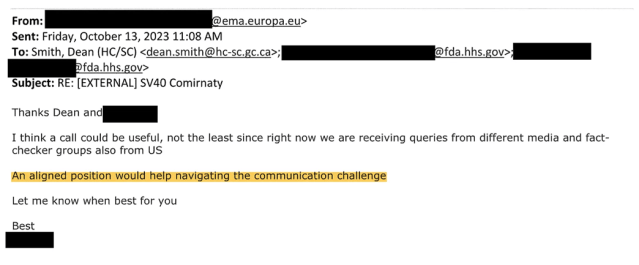
13 October 2023 Source: Scoops McGoo Substack
The emails also call into question regulators’ claims that the size of residual DNA in the Pfizer vaccine is within the 200bp limit, since Pfizer told HC in August last year that no regulators had asked for this information and it had not yet been generated.
In a response to HC’s request that Pfizer provide data on the size distribution of the residual DNA, both fragments and intact plasmids, Pfizer replied:
“…The data are not readily available and will require time to generate. Please note that to date, Pfizer and BioNTech have not been requested to provide these characterisation data across global markets for Original or Omicron drug substances.”
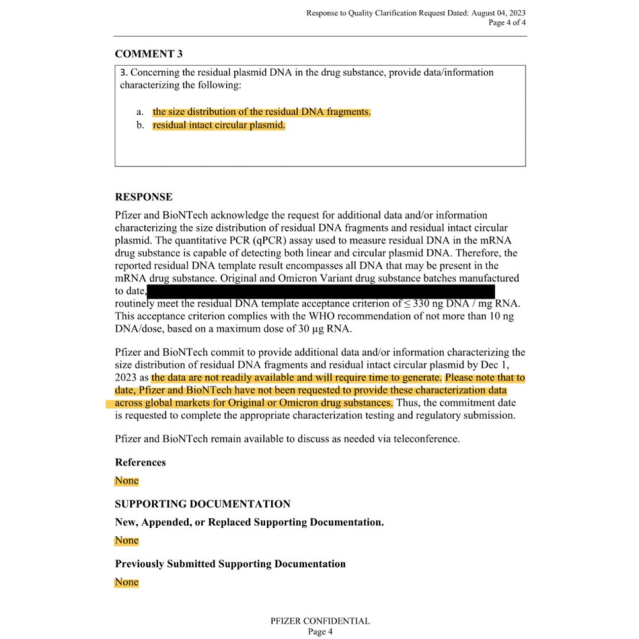
This might explain why Dr. Speicher was able to detect DNA fragments of up to 3.5kb in length (1 bp is 1,000 times smaller than a kb) in the mRNA covid vaccines.
The TGA also took Pfizer’s word for it on its covid vaccine trial results, never having seen or requested patient-level data from Pfizer before approving the COMIRNATY product, according to a Freedom Of Information (“FoI”) response. This is highly relevant given allegations of research fraud (summarised in this audit brief) in the covid vaccine trial levelled at Pfizer.
Just as the TGA appears to place high trust in Pfizer’s word, Australians are supposed to simply trust the TGA when it says that residual DNA is within acceptable limits. When the regulator was asked under FoI to release the results of its spot testing on covid vaccine lots, it ‘released’ 74 fully redacted black pages.
No Evidence for TGA’s Claims
I asked the TGA to provide scientific studies proving that insertional mutagenesis (alteration of the genome) is not occurring with contaminant DNA from the mRNA covid vaccines, but the TGA provided none.
The TGA has also previously advised that the modified RNA cannot affect the human genome either, telling me (for Umbrella News): “Covid-19 vaccines do not alter a person’s DNA. The mRNA in the vaccines does not enter the nucleus of cells and is not integrated into the human genome.”
As evidence for this claim, the TGA provided a Mayo Clinic fact page with no links to studies or scientific evidence of any sort.
Instead, we are supposed to take on face value the TGA’s claim that there is “no accepted science” that shows integration of covid vaccine elements into the human genome.
The word “accepted” is doing a lot of the work here.
In March of this year, I reported on an in vitro (lab dish) experiment (Kämmerer & McKernan) which showed that DNA contamination from the Pfizer vaccine successfully enters human cells, and putative evidence of human DNA integration.
Other studies suggest that the modified RNA used in the covid vaccines have the capacity to genomically integrate. A peer-reviewed study has demonstrated that the Pfizer covid vaccine mRNA can enter the human liver cell line and reverse transcribe into DNA, in vitro.
Another study detected the presence of spike protein mRNA in the nucleus of human cells. And another found that acquired immune traits pass down to the offspring of mice pre-exposed to the covid vaccine mRNA-LNP platform.
None of this is proof of genomic integration. Rather, it is suggestive that DNA integration is possible and should be looked for.
Even without the above-mentioned studies, alteration of the human genome is a known risk of residual DNA, with implications for cancer formation (oncogenic risk).
As stated in the Food and Drug Administration’s (“FDA”) industry guidance (emphasis mine):
“Residual DNA might be a risk to your final product because of oncogenic and/or infectivity potential. There are several potential mechanisms by which residual DNA could be oncogenic, including the integration and expression of encoded oncogenes or insertional mutagenesis following DNA integration. Residual DNA also might be capable of transmitting viral infections if retroviral proviruses, integrated copies of DNA viruses, or extrachromosomal genomes are present.”
One of Moderna’s patents also points to the integration risk of residual DNA packaged in LNPs. It states (emphasis mine):
“There are multiple problems with prior methodologies of delivering pharmaceutical compositions in order to achieve effective protein expression for both therapeutics and bio-processing applications. For example, introduced DNA can integrate into host cell genomic DNA at some frequency, resulting in alterations and/or damage to the host cell genomic DNA. Alternatively, the heterologous deoxyribonucleic acid (DNA) introduced into a cell can be inherited by daughter cells (whether or not heterologous DNA has integrated into the chromosome) or by offspring.”
The same patent details the oncogenic risk of not adequately removing residual DNA:
“The DNA template used in the mRNA manufacturing process must be removed to ensure the efficacy of therapeutics and safety because residual DNA in drug products may induce activation of the innate response and has the potential to be oncogenic in-patient populations.”
While my email exchange with the TGA focussed on the risk of DNA integration, which in turn can pose a cancer risk, Dr. Rose also noted that, according to recent studies, cancer pathways can be initiated simply by the introduction of foreign DNA into the cytoplasm (i.e., inside the cell). That is to say, genomic integration is not required for residual DNA that enters cells to be hazardous.
This is why there are regulatory limits on the amount and size of DNA allowed in vaccines. Regulatory limits that scientists say need to be updated to factor in the effect of LNPs.
Regulator Conflicts and Ineptitude?
The question of whether the TGA can independently regulate drug products without conflicts of interest (“CoI”) remains open. According to a British Medical Journal (BMJ) investigation by Australian investigative journalist Maryanne Demasi, PhD, the TGA receives 96% of its drug regulation funding from industry, more than any other regulator.
The TGA denies that this arrangement presents any CoIs. However, the BMJ report noted that five out of ten committee members responsible for independently advising the TGA and Health Minister on issues related to the safety, quality and efficacy of the expedited covid vaccines declared a financial CoI. This information had to be uncovered, as it is not published on the TGA’s website, and Demasi reported that committee members did not respond to questions on the matter either.
Moreover, the TGA approved more than nine out of every ten applications for new drugs in 2020-2021, more than any other regulator except for the UK’s Medicines and Healthcare products Regulatory Agency (“MHRA”).
The report also identified a problem with the regulator-industry ‘revolving door,’ whereby agency officials end up working or consulting for the companies they previously regulated. A high-profile example is the appointment of former TGA boss Professor John Skerritt to the board of Medicines Australia, Australia’s peak body representing the pharmaceutical industry, less than a year after his resignation from the TGA.
Sociologist Donald Light of Rowan University in New Jersey, US, an expert in drug regulation, told the BMJ that in light of the potential for regulatory capture, regulators need their own independent watchdog. “Countries have independent safety boards for airlines and their passengers. Why not for drugs and patients too?” he said.
A lawsuit challenging the legality of Pfizer and Moderna’s covid vaccine registration in Australia may provide another clue as to why the apparent oversights discussed in this article have occurred on the TGA’s watch.
The case, brought by Victorian GP and pharmacist Dr. Julian Fidge, alleges that the mRNA vaccines contain genetically modified organisms (“GMOs”) in the form of both the LNP-mod-RNA complexes and the contaminant DNA. If that were true, then the Office of the Gene Technology Regulator (“OGTR”) would be required to conduct an assessment of the mRNA vaccines to determine safety – something that the TGA is not equipped to do because it does not regulate GMOs.
The OGTR denies that the mRNA vaccines contain GMOs, however this will ultimately be decided in the courts if the case gets a full hearing. I say if because the lawsuit was dismissed on the technicality of “standing” several months ago by a judge who allegedly did not disclose that she had previously provided legal counsel to Pfizer on at least five occasions. Dr. Fidge’s lawyers are currently seeking to have the dismissal voided, and have also turned to the parliament for intervention.
To build their case, Dr. Fidge’s legal team commissioned a study of residual DNA levels in Australian mRNA Pfizer and Moderna covid vaccine vials. The study, conducted by Dr. Speicher, uses both qPCR and fluorometry to measure the amount of DNA.
“My findings will be released in coming days and will greatly question TGA’s response,” said Dr. Speicher earlier today [24 July].
Notes:
1 Dr. Buckhaults has since tested more vials of Pfizer and Moderna Covid vaccines which came in under regulatory limits. He posted to X that the 2023 Pfizer vials he tested were “cleaner” than the 2020 vials, and that Moderna was comparatively cleaner than Pfizer.
2 Pathology and haematology labs wishing to send samples to Dr. Buckhaults are invited to contact him at the University of South Carolina.
3 Health Canada (“HC”) claims that the SV40 sequence in the Pfizer vaccine is not a concern. “The fragment is inactive, has no functional role, and was measured to be consistently below the limit required by Health Canada and other international regulators,” HC told AFP Fact Check.
Nevertheless, internal emails show that HC is working to get the SV40 enhancer removed from Pfizer’s vaccine. A draft Clarifax response emailed from Senior HC Biologist/Evaluator Michael Wall to HC Manager of Vaccine Quality Tong Wu states, “Health Canada will continue to work with international regulator partners to achieve harmonisation regarding removal of these sequence elements from the plasmid for future strain changes.”
The FDA misleadingly refuted the presence of SV40 proteins in the vaccines in response to concerns raised by Florida Surgeon General Dr Joseph A. Ladapo about the presence of the SV40 enhancer sequence.
The TGA has not acknowledged the presence of the SV40 sequence in the Pfizer vaccine.
About the Author
Rebekah Barnett is an Australian independent journalist. You can follow Barnett on her Substack page ‘Dystopian Down Under’ HERE, Twitter HERE and Instagram HERE. To support her work, you can make a one-off contribution to Dystopian Down Under’s Ko-fi account HERE.
She is also a volunteer interviewer for ‘Jab Injuries Australia’, a website that collects stories of people who claim to have been injured by covid vaccines.
